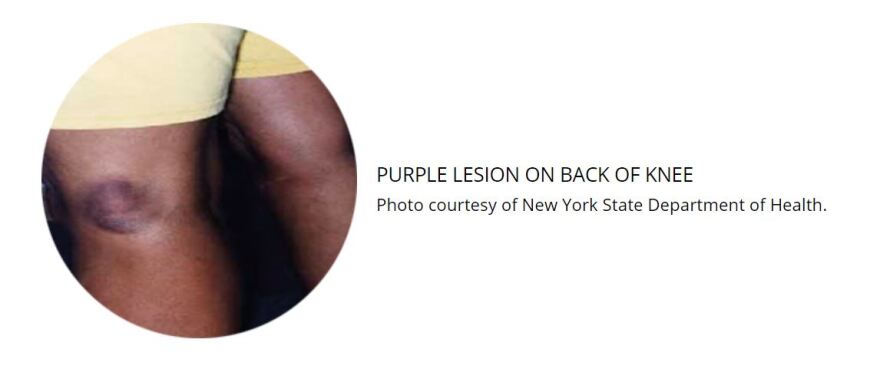This week, Taylor Quimby, host of the NHPR podcast Patient Zero, is bringing us “Tick season:” straightforward advice on tick-borne disease.
Today, in the final installment of the series: diagnosing tick-borne disease during a coronavirus pandemic.
Editor's Note: This series originally published in May 2020.
You may have heard that the symptoms of Lyme disease are all over the place: joint pain, meningitis, facial paralysis.
It’s true that Lyme can present in a lot of different ways, and there are many possible symptoms if Lyme disease goes untreated. But early on, a lot of people with Lyme do experience something similar: flu-like symptoms and a funny rash that’s sometimes colored like the bulls-eye of a dartboard. The key is sometimes...but not always.
“It often doesn’t look just like a bullseye, it can be a reddened rash,” says Erik Foster, a medical entomologist with the Centers for Disease Control and Prevention (CDC). “It can be elongated. It doesn’t have to be round.”

If you have any flu-like symptoms or a rash after a tick-bite, Foster says you should see your health care provider immediately.
Of course, not everybody wants to see the doctor in person these days. Luckily, hospitals and urgent care facilities all across the country have been ramping up their efforts to conduct medicine via screens.
Tim Lahey is an infectious disease doctor at the University of Vermont Medical Center.
“A telemedicine visit could be a great way to get your initial evaluation for Lyme disease, and that may be all that you need.”
If you’ve got a bullseye rash that can be seen by a webcam and a history of exposure to ticks, that’s enough clinical evidence for a Lyme disease diagnosis.

Your virtual health care provider can send a prescription for antibiotics to your local pharmacy, and you can start treatment. Unfortunately, Tim notes that not all patients get the characteristic rash after being infected with Lyme disease. In those cases, diagnosis may require an in-person evaluation (or several) and blood testing.
“It can be a diagnostic puzzle,” says Lahey.
Many people who acquire a tick-borne disease don’t remember being bitten by a black-legged tick.
That’s why Erik Foster says to err on the side of caution if you’ve got flu-like symptoms in the summer, even if you don’t recall being bitten by a tick. Here in New Hampshire, where Lyme is endemic, summertime symptoms like fever, rash, and body aches could all be indicative of Lyme.
“Or it might not be Lyme,” Foster says. “It could be another tick-borne disease such as anaplasmosis, babesiosis, or ehrlichiosis. There’s a lot of similarities in the early symptoms in these diseases, and it’s always best to be cognizant of that and go see your healthcare provider.”

Covid-19 and Lyme disease
Dr. Paul Auwaerter is Clinical Director for infectious diseases at Johns Hopkins and former president of the Infectious Diseases Society of America. He says that one of the challenges doctors will have this summer is that people with a flu-like illness may think they have Covid-19.
Editor's note: This story first published in May, 2020.
“People will be concerned that coronavirus is more frequent, so you go to the more frequent diagnosis first,” Auwaerter says. “This is very normal.”
However, there is one symptom - aside from the bullseye rash - that can help distinguish Lyme from Covid-19: a cough. Lyme disease can infiltrate many parts of the body, but it isn’t known to cause any of the respiratory symptoms linked to Covid-19.
Nevertheless, both diseases can present in subtle ways. Dr. Lahey and Dr. Auwaerter both agree that there’s enough overlap between the two diseases that some Lyme cases will likely get missed this summer in the rush to rule out coronavirus.
“There may be a delay in reaching the right diagnosis,” Auwaerter says.
Maria Diuk Wasser is a disease ecologist at Columbia University. With so many people starting gardens, getting out for local hikes, and inadvertently exposing themselves to tick habitat, she wonders if more people may be at risk than is typical.
“I think people will probably be more exposed, but we don’t know for sure so that’s something we want to study.”
Unfortunately, the coronavirus pandemic has also delayed or even halted research into ticks and tick-borne illnesses. Paul Auwaerter’s research at Johns Hopkins has been suspended, and Maria Diuk-Wasser says social distancing has prevented tick researchers from collecting the ticks required for disease surveillance.
“So that’s a worse scenario, where there’s more people sick and we don’t know about it or we can’t really measure it,” says Diuk-Wasser.
Phase II trials for a Lyme vaccine have been positive, but with FDA approval at least three or four years away, the best way to stay disease free is to stick with the basics: socks over pants, bug spray, and daily tick checks.
“We should still enjoy the outdoors,” Diuk-Wasser says. “The outdoors is what we can do, and it’s a wonderful thing and so I really would like people to go out. Just do it safely.”
You can learn more about Lyme disease by listening to the Patient Zero podcast, wherever you get your podcasts.







